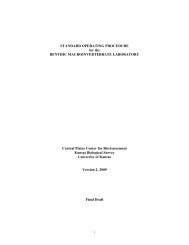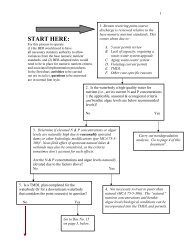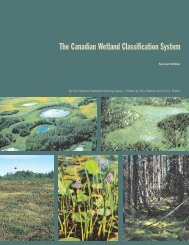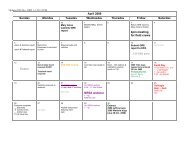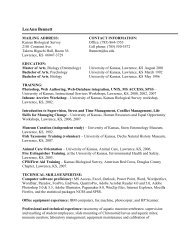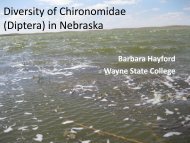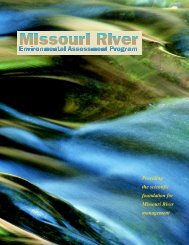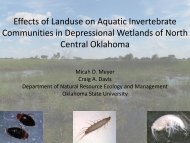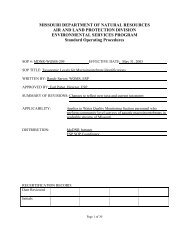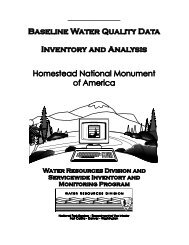Koontz, J., D.G. Huggins, C.C. Freeman, D.S. Baker - Central Plains ...
Koontz, J., D.G. Huggins, C.C. Freeman, D.S. Baker - Central Plains ...
Koontz, J., D.G. Huggins, C.C. Freeman, D.S. Baker - Central Plains ...
Create successful ePaper yourself
Turn your PDF publications into a flip-book with our unique Google optimized e-Paper software.
Total Nitrogen mg/L<br />
Mean Conductivity uS/cm<br />
10<br />
1<br />
.1<br />
1<br />
.1<br />
.01<br />
a<br />
1 2<br />
Study Phase<br />
c<br />
1 2<br />
Study Phase<br />
Chlorophyll a ug/L<br />
Herbicides Detected<br />
Figure 45. Median box plots of water quality parameters that were significantly different<br />
between study populations for (a) log total nitrogen mg/L, (b) log chlorophyll-a, (c) log mean<br />
conductivity mS/cm, and (d) the number of herbicides detected. Box area represents inner<br />
quartile range, while “whiskers” represent the upper and lower observations.<br />
All metrics that discriminated between the identified a priori groups in the metric selection<br />
process were tested for congruency with other wetland assessment tools and water quality<br />
parameters using ANOVA or Kruskal-Wallace analysis. Metric scores for percent burrowers,<br />
count of heavy metal (HM) intolerant taxa, and count of taxa intolerant to suspended solids and<br />
sediments (SSS) were the only metrics found to be significantly different between the two study<br />
populations (Figure 46). However, the log transformed mean percent Hydroptilidae was<br />
significantly different (p = 0.004) between study populations suggesting that this metric could<br />
discriminate between the populations if the measurement scale was adjusted (use of log values or<br />
some other transformation). Counts of intolerant taxa to heavy metals and percent burrowers<br />
were normally distributed and were statistically different between populations. Percent<br />
burrowers (mean = 38.7) was significantly lower in reference sample than the random samples<br />
(mean = 54.3). Counts of intolerant taxa to heavy metals were highest in the reference (mean =<br />
17.4) population when tested against the random population (mean = 13.3).<br />
1000<br />
100<br />
10<br />
.1<br />
63 of 84<br />
1<br />
8<br />
7<br />
6<br />
5<br />
4<br />
3<br />
2<br />
1<br />
0<br />
b<br />
1 2<br />
Study Phase<br />
d<br />
1 2<br />
Study Phase



